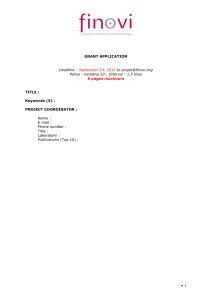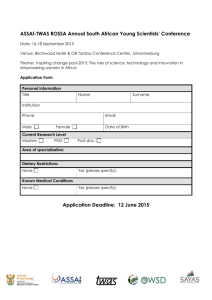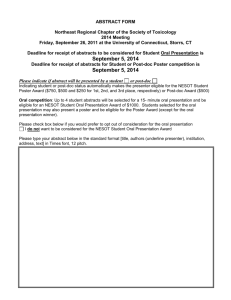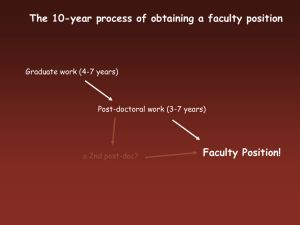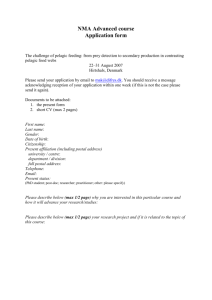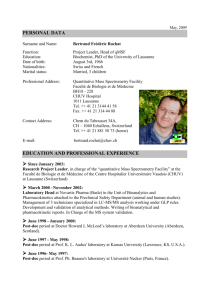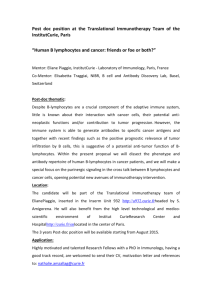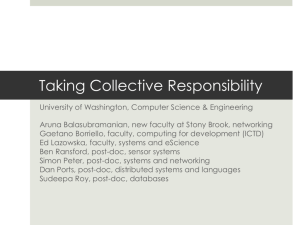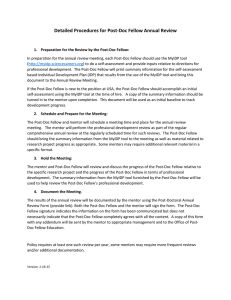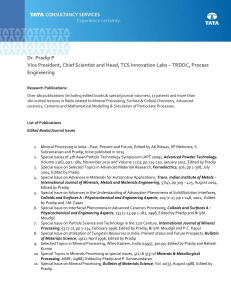Practicing Project Management : A Case Study
advertisement
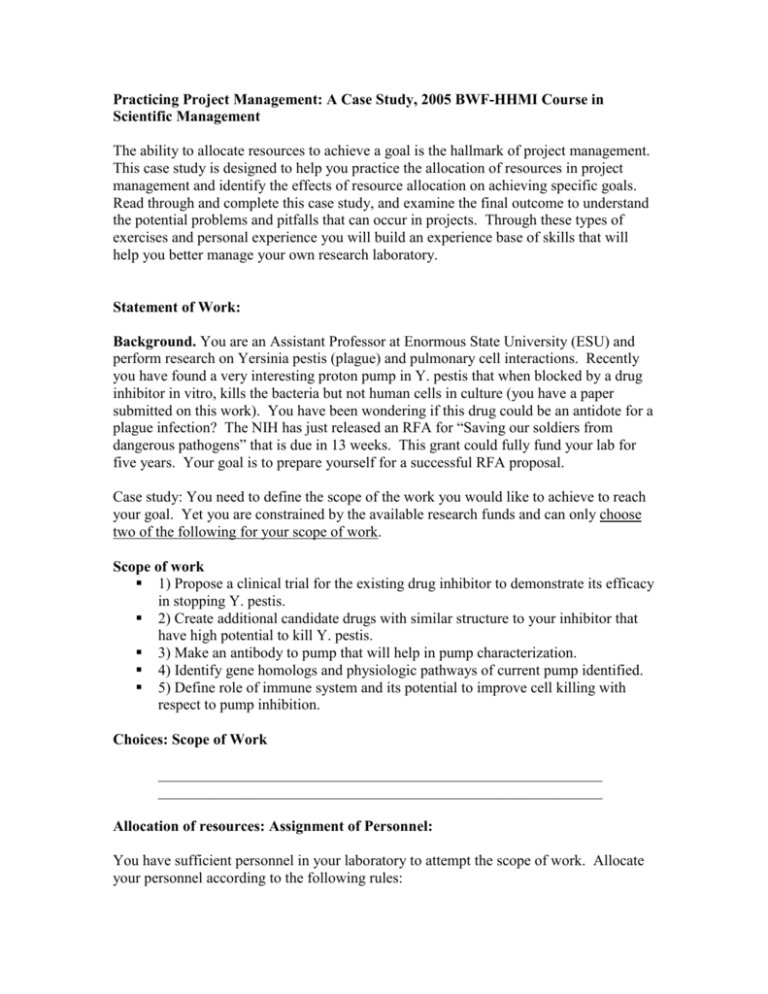
Practicing Project Management: A Case Study, 2005 BWF-HHMI Course in Scientific Management The ability to allocate resources to achieve a goal is the hallmark of project management. This case study is designed to help you practice the allocation of resources in project management and identify the effects of resource allocation on achieving specific goals. Read through and complete this case study, and examine the final outcome to understand the potential problems and pitfalls that can occur in projects. Through these types of exercises and personal experience you will build an experience base of skills that will help you better manage your own research laboratory. Statement of Work: Background. You are an Assistant Professor at Enormous State University (ESU) and perform research on Yersinia pestis (plague) and pulmonary cell interactions. Recently you have found a very interesting proton pump in Y. pestis that when blocked by a drug inhibitor in vitro, kills the bacteria but not human cells in culture (you have a paper submitted on this work). You have been wondering if this drug could be an antidote for a plague infection? The NIH has just released an RFA for “Saving our soldiers from dangerous pathogens” that is due in 13 weeks. This grant could fully fund your lab for five years. Your goal is to prepare yourself for a successful RFA proposal. Case study: You need to define the scope of the work you would like to achieve to reach your goal. Yet you are constrained by the available research funds and can only choose two of the following for your scope of work. Scope of work 1) Propose a clinical trial for the existing drug inhibitor to demonstrate its efficacy in stopping Y. pestis. 2) Create additional candidate drugs with similar structure to your inhibitor that have high potential to kill Y. pestis. 3) Make an antibody to pump that will help in pump characterization. 4) Identify gene homologs and physiologic pathways of current pump identified. 5) Define role of immune system and its potential to improve cell killing with respect to pump inhibition. Choices: Scope of Work ___________________________________________________________ ___________________________________________________________ Allocation of resources: Assignment of Personnel: You have sufficient personnel in your laboratory to attempt the scope of work. Allocate your personnel according to the following rules: Choose only two scope projects. You must do the ongoing lab work. Each person can only do one scope project/ongoing lab work. You need at least one person per scope project. You can have up to two people per project. You must have people covering the ongoing lab work (one for each column). Different personnel have different research strengths and can or cannot function in different projects. Their abilities are listed in the following table. You can consider a degree of redundancy in the work assignments that you may want in case of personnel loss or turnover. Name Person Rudy Physicianscientist ChiaLing Suzanne Graduate student Post-doc Hortence Post-doc Pradip Post-doc Scope 1 Best Scope 2 Poor Scope 3 Scope Scope 5 4 Adequate Best Poor Best Adequate Poor Poor Best Best Adequate Poor Adequate Best Adequate Poor Poor Best Poor Poor Ongoing Lab Work 1 Poor Poor Adequate Best Adequate Adequate Best Adequate Best Adequate Best Best Adequate Things Happen! In the course of all events it is certain that things will go wrong. While you are working on your projects the following things have happened in the laboratory. These will affect your work, and the ability to complete your goal. Ongoing Lab Work 2 Poor Rudy quits the laboratory to join a private practice medicine group. If you want to continue Scope 1 you need to place another person on the project (if you do not already have another person covering the project). Bob’s Brain Foundation, the group funding your brain tumor research, decides to perform a review of your program. To keep funding you need to show significant progress. You need your “best” people doing the ongoing lab work. Modify your available resources to best accomplish you goals. You may also change your scope projects, just realize it is a “bit late in the game” to be changing scope projects. Name Person ChiaLing Suzanne Graduate student Post-doc Hortence Post-doc Pradip Post-doc Scope 1 Scope 2 Scope 3 Poor Best Adequate Poor Poor Best Best Adequate Poor Adequate Best Adequate Scope Scope 5 4 Poor Poor Best Poor Ongoing Lab Work 1 Poor Adequate Adequate Adequate Adequate Best Best Best More Things Happen! Ongoing events affect your final productivity. Hortence is sick and cannot complete her assigned tasks her productivity goes from “Best” to “Adequate”, or from “Adequate” to “Poor” depending on the task she has been assigned. DO NOT make any additional changes to the table. Copy your previous results onto the new table and calculate your point score. Ongoing Lab Work 2 Best Best Adequate Adequate Final productivity Name Person Chia-Ling Graduate student Suzanne Post-doc Hortence (sick) Post-doc Pradip Post-doc Scope 1 Scope 2 Poor Best 1 Point 3 Points Poor Poor 1 Point 1 Point Adequate Poor 2 Points 1 Point Adequate Best 2 Points 3 Points Scope 3 Scope 4 Scope 5 Ongoing Lab Work 1 Adequate Poor Poor Adequate 2 Points 1 Point 1 Point 2 Points Best Poor Adequate Adequate 3 Points 1 Point 2 Points 2 Points Poor Adequate Poor Adequate 1 Point 2 Points 1 Point 2 Points Adequate Poor Best Best 2 Points 1 Point 3 Points 3 Points Examine the table above. Using the columns, copy the check boxes of the scope projects and personnel you used from the previous table. Record the points you received for each project at the bottom. If you chose a project and at least one of the personnel you placed on the project had a “Best” score it as 3 points. If the personnel had “Adequate” score it as 2 points. Add up your points and place the sum in the “TOTAL POINTS” Box. If the personnel had “Poor” score it as 1 point. If you switched any projects between table one and table 2 (i.e. after the misfortune) subtract 2 points from your total. TOTAL POINTS SUBTRACT 2 POINTS IF YOU CHANGES SCOPES FINAL POINTS Final Point scoring: FINAL POINTS 10-12 8-9 0-7 OUTCOME Excellent- Kept current lab funding and added new grant Good-Kept current lab funding Poor – Too high risk, lost all lab funding Ongoing Lab Work 2 Best 3 Points Best 3 Points Poor 1 Point Adequate 2 Points The goal of this case study is not to win, but to see how ongoing events can affect your laboratory, and how project management can help you control your resources for your benefit. Key things to consider as you analyze your projects. After the initial things went wrong, how did you reallocate your resources? How much risk were you willing to take? If you lost a scope project, did you refocus on protecting the current lab funding? Were you willing to risk your current lab funding to get more funding? What would you do differently next time? This case study was developed by Milton Datta, M.D., Emory University, for the session on project planning at the 2005 BWF-HHMI Course in Scientific Management
